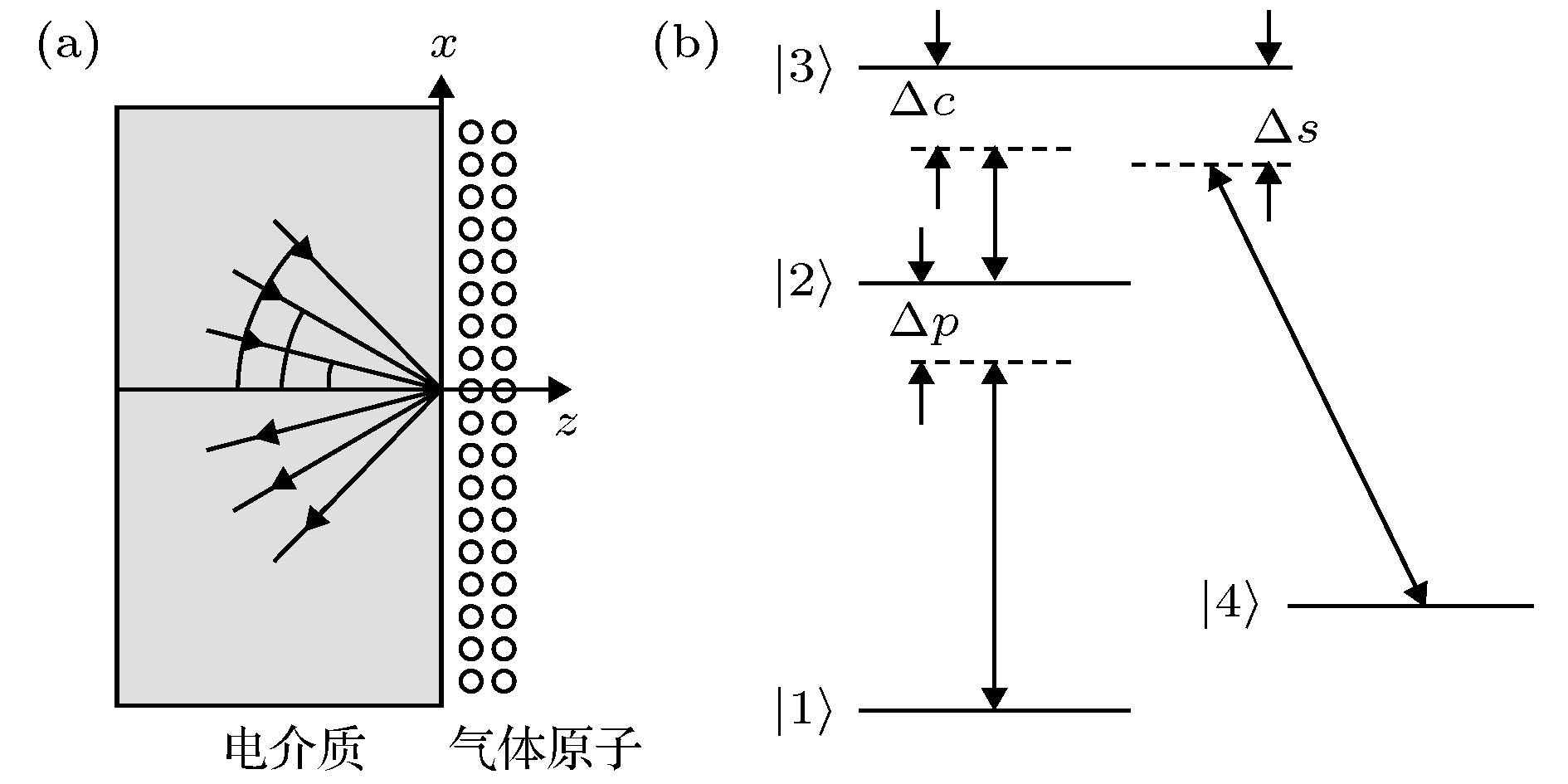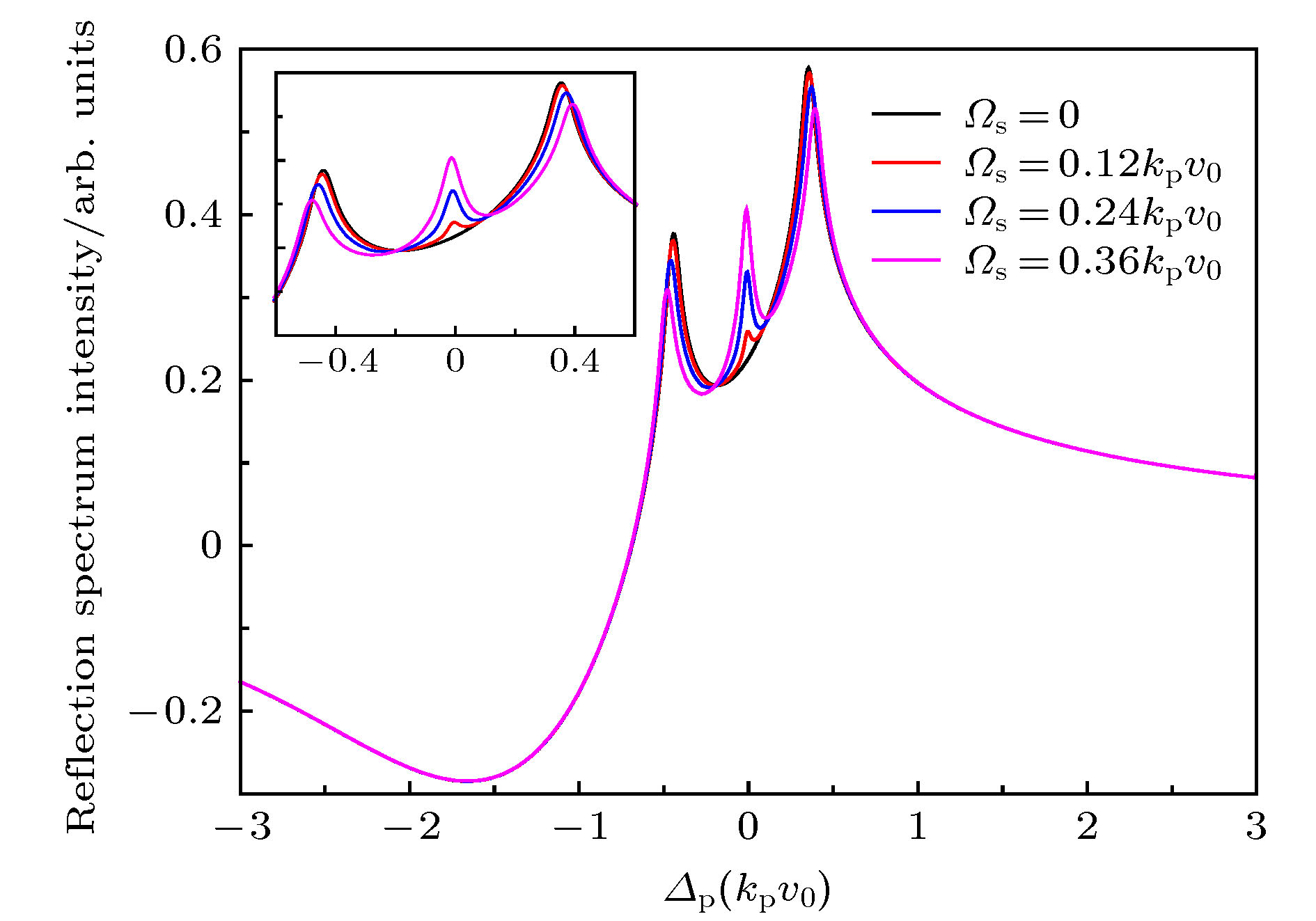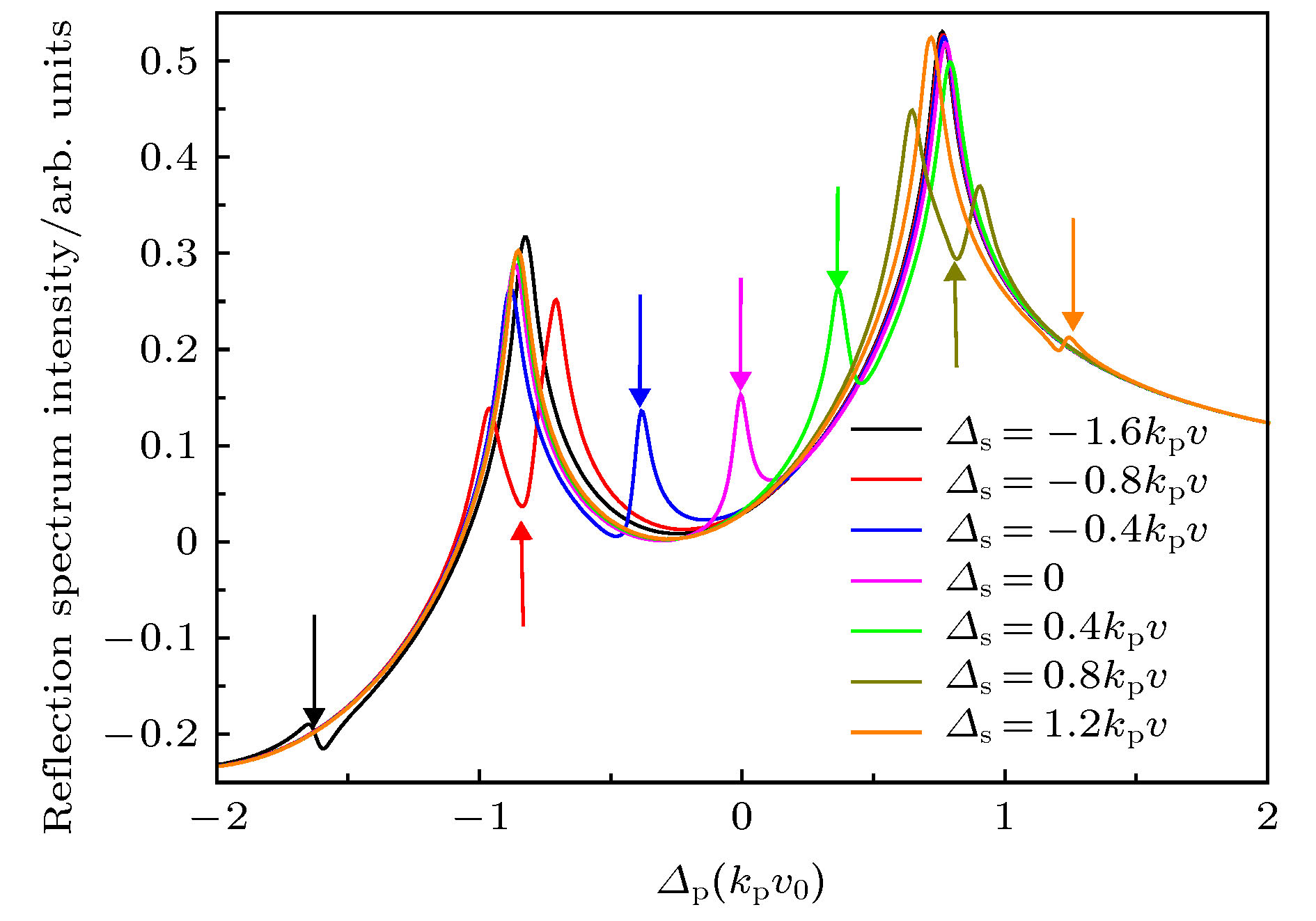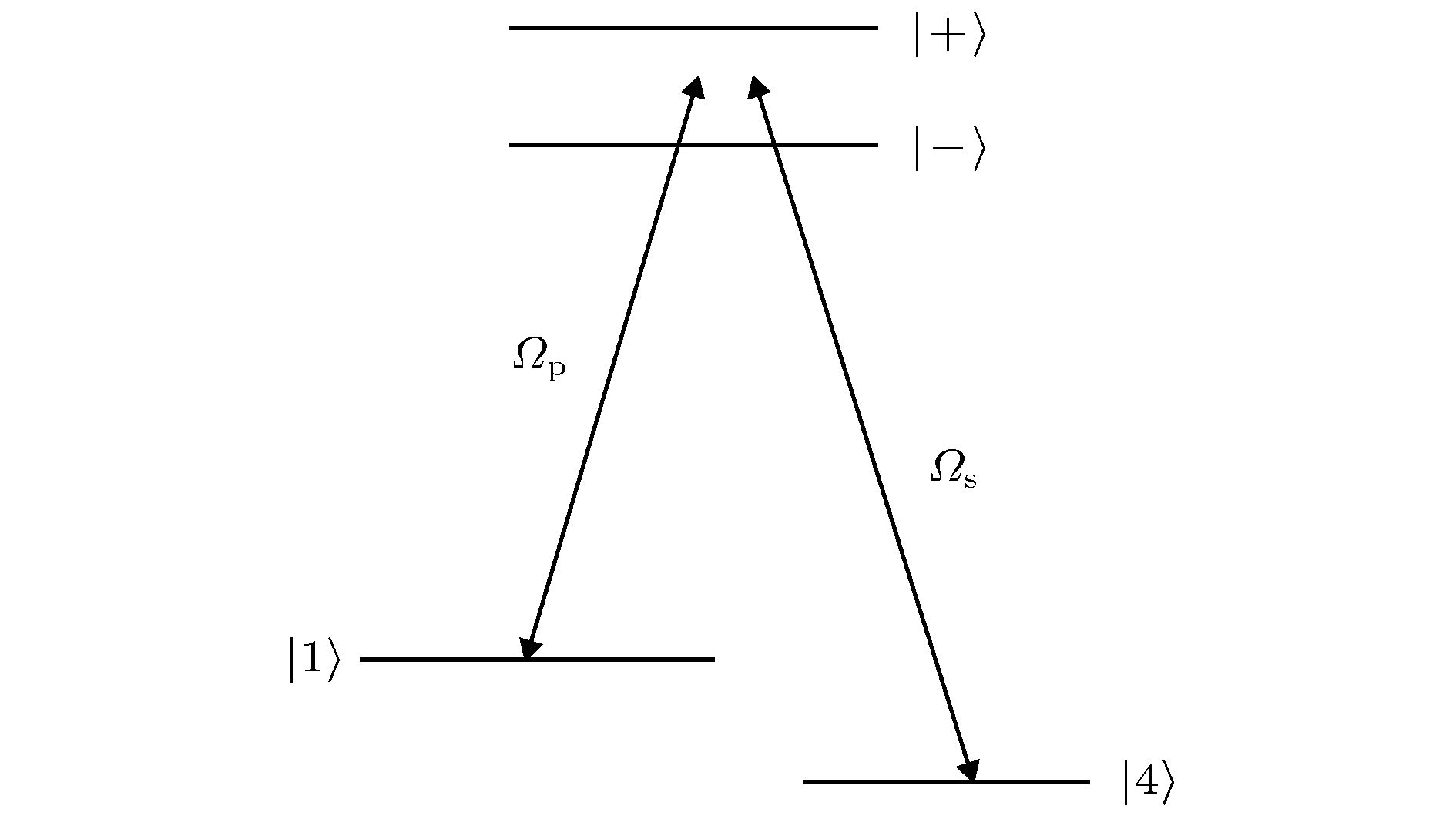-
运用密度矩阵理论研究了气固界面准
$\Lambda$ 型四能级原子系统的非线性选择反射光谱. 基于刘维尔方程给出了一阶近似条件下探测光场的解析式. 在探测场为弱场时, 分析了信号场拉比频率、失谐量和耦合场失谐量对反射光谱线型的影响. 数值模拟表明: 信号场参与产生的选择反射峰线宽可以利用信号场拉比频率进行调节, 通过调节信号场频率失谐量可以实现选择反射峰到透明窗口的转化, 选择反射峰和透明窗口的位置可以通过耦合场失谐量实现调谐. 利用三种电子跃迁路径以及缀饰态理论对所得结果进行了解释. 本文结果为研究气固界面原子的量子相干和动力学过程提供理论参考.Selective reflection (SR) from the interface between transparent medium and dilute vapour is caused by the atomic vapor near the interface. The sub-Doppler structure in SR is due to the deexcitation caused by the collision between atomic vapor and the wall. Beacuse the interaction region between atomic vapor and incident light is on the order of a few hundred nanometers, SR has low optical loss and high spatial resolution. The experimental device of SR is simple. Because of the above characteristics, the SR has been widely studied and applied. The nonlinear SR spectrum of quasi lambda-type four-level system at gas-solid interface is studied theoretically in this paper. By sloving the density matrix equations, the approximate analytic solution of the matrix element associated with the probe field is obtained at normal incidence when the intensity of the probe field is very weak. The effect of the Rabi frequency, the detuning of the signal field and the detuning of the coupling field on the lineshape are analyzed by numerical simulation, respectively. Three peaks and two transparent windows appear in SR spectrum when the detuning of coupling field and signal field are both zero. The middle peak is generated due to the participation of signal field, and the other two peaks are caused by the other two fields. The linewidth and the amplitude of the middle peak can be changed by varying the Rabi frequency of signal field, and the other two peaks have little effect on the Rabi frequency of signal field. The signal generated due to the participation of signal field can be transformed from peak to transparent window when the detuning value of the signal field is equal to the Rabi frequency of coupling field. When the detuning value of the signal field is not equal to the Rabi frequency of coupling field, a dispersion-like signal between reflection peak and transparent window is generated due to the participation of signal field. The position of peak and transparent window can be manipulated by controlling the detuning value of the coupling field. When the detuning value of coupling field decreases from zero, three peaks all shift to red detuning direction. When the detuning value of coupling field is blue-detuned and increases, three peaks all shift to blue detuning direction. The numerical results can be explained by using the various electric transition pathways and dressed state theory. This study is helpful in investigating quantum coherence and dynamic process of atoms at gas-solid interface.-
Keywords:
- selective reflection spectroscopy /
- electron transition /
- dressed state /
- quasi lambda-type four-level system
[1] Schuurmans M F H 1976 J. Phys. (Paris) 37 469
 Google Scholar
Google Scholar
[2] Thomas R, Kupchak C, Agarwal G S, Lvovsky A I 2013 Opt. Express 21 6880
 Google Scholar
Google Scholar
[3] Du C, Jing Q, Hu Z 2015 Phys. Rev. A 91 013817
 Google Scholar
Google Scholar
[4] Khachatryana D N, Grigoryan G G 2019 J. Contemp. Phys. (Armenian Ac. Sci.) 54 185
 Google Scholar
Google Scholar
[5] Sautenkov V A, Rostovtsev Y V, Eliel E R 2008 Phys. Rev. A 78 013802
 Google Scholar
Google Scholar
[6] Zhao Y T, Zhao J M, Huang T, Xiao L T, Jia S T 2005 Chin. Phys. Lett. 22 1668
 Google Scholar
Google Scholar
[7] Lorenz V O, Cundiff S T 2005 Phys. Rev. Lett. 95 163601
 Google Scholar
Google Scholar
[8] Thomas R J 2012 Ph. D. Dissertation (Calgary: University of Calgary
[9] Keaveney J, Hughes I G, Sargsyan A, Sarkisyan D, Adams C S 2012 Phys. Rev. Lett. 109 233001
 Google Scholar
Google Scholar
[10] Stern L, Grajower M, Levy U 2014 Nat. Commun. 5 4865
 Google Scholar
Google Scholar
[11] Sautenkov V A, van Kampen H, Eliel E R, Woerdman J P 1996 Phys. Rev. Lett. 77 3327
 Google Scholar
Google Scholar
[12] Li H, Varzhapetyan T S, Sautenkov V A, Rostovtsev Y V, Chen H, Sarkisyan D, Scully M O 2008 Appl. Phys. B 91 229
[13] Sargsyan A, Klinger E, Hakhumyan G, Tonoyan A, Papoyan A, Leroy C, Sarkisyan D 2017 J. Opt. Soc. Am. B 34 776
 Google Scholar
Google Scholar
[14] Klinger E, Sargsyan A, Tonoyan A, Hakhumyan G, Papoyan A, Leroy C, Sarkisyan D 2017 Eur. Phys. J. D 71 216
 Google Scholar
Google Scholar
[15] Nienhuis G, Schuller F, Ducloy M 1988 Phys. Rev. A 38 5197
 Google Scholar
Google Scholar
[16] Guo J, Cooper J, Gallagher A 1996 Phys. Rev. A 53 1130
 Google Scholar
Google Scholar
[17] Khachatryan D N 2019 Opt. Commun. 436 76
 Google Scholar
Google Scholar
[18] Nienhuis G, Schuller F 1994 Phys. Rev. A 50 1586
 Google Scholar
Google Scholar
[19] Li Y Y, Li L, Lu Y X, Zhao X X, Xu K W, Zhang Y Q, Zhang Y P 2013 Opt. Express 21 8311
 Google Scholar
Google Scholar
[20] Meng T F, Ji Z H, Su D Q, Zhao Y T, Xiao L T, Jia S T 2016 Ann. Phys. (Berlin) 528 512
 Google Scholar
Google Scholar
[21] Schuller F, Amy-Klein A, Saltiel S 1996 Phys. Rev. A 53 3647
 Google Scholar
Google Scholar
[22] Gorris-Neveux M, Monnot P, Saltiel S, Barbé R, Keller J C, Ducloy M 1996 Phys. Rev. A 54 3386
 Google Scholar
Google Scholar
[23] Sargsyan A, Papoyan A, Hughes I G, Adams C S, Sarkisyan D 2017 Opt. Lett. 42 1476
 Google Scholar
Google Scholar
[24] Yan J L, Ota F, San Jose B A, Akagi K 2016 Adv. Funct. Mater. 27 1604529
[25] 黄巍, 梁振涛, 杜炎雄, 颜辉, 朱诗亮 2015 物理学报 64 160702
 Google Scholar
Google Scholar
Huang W, Liang Z T, Du Y X, Yan H, Zhu S L 2015 Acta Phys. Sin. 64 160702
 Google Scholar
Google Scholar
[26] Alotaibi H M M, Sanders B C 2016 Phys. Rev. A 94 053832
 Google Scholar
Google Scholar
[27] Rebić S, Vitali D, Ottaviani C, Tombesi P, Artoni M, Cataliotti F, Corbalán R 2004 Phys. Rev. A 70 032317
 Google Scholar
Google Scholar
[28] Niu Y P, Gong S Q, Li R X, Xu Z Z, Liang X Y 2005 Opt. Lett. 30 3371
 Google Scholar
Google Scholar
[29] Mahmoudi M, Fleischhaker R, Sahrai M, Evers J 2008 J. Phys. B: At. Mol. Opt. Phys. 41 025504
 Google Scholar
Google Scholar
[30] Gea-Banacloche J, Li Y Q, Jin S Z, Xiao M 1995 Phys. Rev. A 51 576
 Google Scholar
Google Scholar
[31] Wielandy S, Gaeta A L 1998 Phys. Rev. A 58 2500
 Google Scholar
Google Scholar
[32] Schuller F, Gorceix O, Ducloy M 1993 Phys. Rev. A 47 519
 Google Scholar
Google Scholar
-
-
[1] Schuurmans M F H 1976 J. Phys. (Paris) 37 469
 Google Scholar
Google Scholar
[2] Thomas R, Kupchak C, Agarwal G S, Lvovsky A I 2013 Opt. Express 21 6880
 Google Scholar
Google Scholar
[3] Du C, Jing Q, Hu Z 2015 Phys. Rev. A 91 013817
 Google Scholar
Google Scholar
[4] Khachatryana D N, Grigoryan G G 2019 J. Contemp. Phys. (Armenian Ac. Sci.) 54 185
 Google Scholar
Google Scholar
[5] Sautenkov V A, Rostovtsev Y V, Eliel E R 2008 Phys. Rev. A 78 013802
 Google Scholar
Google Scholar
[6] Zhao Y T, Zhao J M, Huang T, Xiao L T, Jia S T 2005 Chin. Phys. Lett. 22 1668
 Google Scholar
Google Scholar
[7] Lorenz V O, Cundiff S T 2005 Phys. Rev. Lett. 95 163601
 Google Scholar
Google Scholar
[8] Thomas R J 2012 Ph. D. Dissertation (Calgary: University of Calgary
[9] Keaveney J, Hughes I G, Sargsyan A, Sarkisyan D, Adams C S 2012 Phys. Rev. Lett. 109 233001
 Google Scholar
Google Scholar
[10] Stern L, Grajower M, Levy U 2014 Nat. Commun. 5 4865
 Google Scholar
Google Scholar
[11] Sautenkov V A, van Kampen H, Eliel E R, Woerdman J P 1996 Phys. Rev. Lett. 77 3327
 Google Scholar
Google Scholar
[12] Li H, Varzhapetyan T S, Sautenkov V A, Rostovtsev Y V, Chen H, Sarkisyan D, Scully M O 2008 Appl. Phys. B 91 229
[13] Sargsyan A, Klinger E, Hakhumyan G, Tonoyan A, Papoyan A, Leroy C, Sarkisyan D 2017 J. Opt. Soc. Am. B 34 776
 Google Scholar
Google Scholar
[14] Klinger E, Sargsyan A, Tonoyan A, Hakhumyan G, Papoyan A, Leroy C, Sarkisyan D 2017 Eur. Phys. J. D 71 216
 Google Scholar
Google Scholar
[15] Nienhuis G, Schuller F, Ducloy M 1988 Phys. Rev. A 38 5197
 Google Scholar
Google Scholar
[16] Guo J, Cooper J, Gallagher A 1996 Phys. Rev. A 53 1130
 Google Scholar
Google Scholar
[17] Khachatryan D N 2019 Opt. Commun. 436 76
 Google Scholar
Google Scholar
[18] Nienhuis G, Schuller F 1994 Phys. Rev. A 50 1586
 Google Scholar
Google Scholar
[19] Li Y Y, Li L, Lu Y X, Zhao X X, Xu K W, Zhang Y Q, Zhang Y P 2013 Opt. Express 21 8311
 Google Scholar
Google Scholar
[20] Meng T F, Ji Z H, Su D Q, Zhao Y T, Xiao L T, Jia S T 2016 Ann. Phys. (Berlin) 528 512
 Google Scholar
Google Scholar
[21] Schuller F, Amy-Klein A, Saltiel S 1996 Phys. Rev. A 53 3647
 Google Scholar
Google Scholar
[22] Gorris-Neveux M, Monnot P, Saltiel S, Barbé R, Keller J C, Ducloy M 1996 Phys. Rev. A 54 3386
 Google Scholar
Google Scholar
[23] Sargsyan A, Papoyan A, Hughes I G, Adams C S, Sarkisyan D 2017 Opt. Lett. 42 1476
 Google Scholar
Google Scholar
[24] Yan J L, Ota F, San Jose B A, Akagi K 2016 Adv. Funct. Mater. 27 1604529
[25] 黄巍, 梁振涛, 杜炎雄, 颜辉, 朱诗亮 2015 物理学报 64 160702
 Google Scholar
Google Scholar
Huang W, Liang Z T, Du Y X, Yan H, Zhu S L 2015 Acta Phys. Sin. 64 160702
 Google Scholar
Google Scholar
[26] Alotaibi H M M, Sanders B C 2016 Phys. Rev. A 94 053832
 Google Scholar
Google Scholar
[27] Rebić S, Vitali D, Ottaviani C, Tombesi P, Artoni M, Cataliotti F, Corbalán R 2004 Phys. Rev. A 70 032317
 Google Scholar
Google Scholar
[28] Niu Y P, Gong S Q, Li R X, Xu Z Z, Liang X Y 2005 Opt. Lett. 30 3371
 Google Scholar
Google Scholar
[29] Mahmoudi M, Fleischhaker R, Sahrai M, Evers J 2008 J. Phys. B: At. Mol. Opt. Phys. 41 025504
 Google Scholar
Google Scholar
[30] Gea-Banacloche J, Li Y Q, Jin S Z, Xiao M 1995 Phys. Rev. A 51 576
 Google Scholar
Google Scholar
[31] Wielandy S, Gaeta A L 1998 Phys. Rev. A 58 2500
 Google Scholar
Google Scholar
[32] Schuller F, Gorceix O, Ducloy M 1993 Phys. Rev. A 47 519
 Google Scholar
Google Scholar
计量
- 文章访问数: 10010
- PDF下载量: 98
- 被引次数: 0
















 下载:
下载:





















